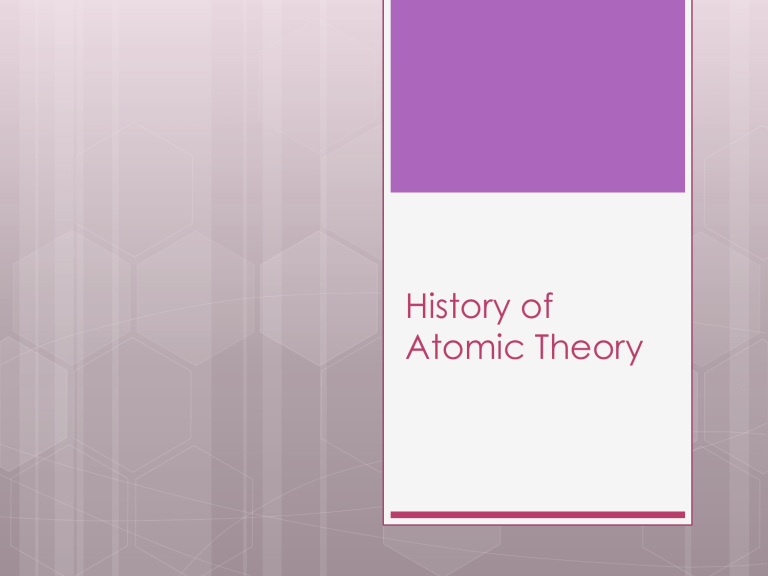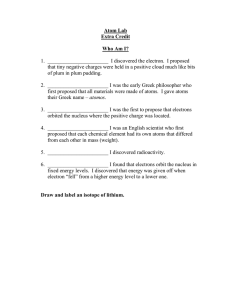History of Atomic Theory PPT
advertisement

History of Atomic Theory Timeline 400-350BC 1803 1897 1911 1912 1913 1924 -1928 1932 1932 Greek Philosophers’ Views Modern Atomic Theory Electron Discovered Protons & Nucleus Discovered Electron’s Charge Measured Bohr Model of the Atom Quantum Model of the Atom Neutron Discovered Lithium Atom Split Greek Philosophers’ Views Democritus 400 BC Matter is made of small particles called atoms. These particles can not be divided any further. Correct, but rejected Aristotle 350 BC Matter is made of air, water, fire and earth. It can always be divided into smaller pieces. There is no base unit. Incorrect, but accepted 1803 Dalton’s Modern Atomic Theory 1. 2. 3. 4. 5. Matter is made up of atoms that are indivisible and indestructible. All atoms of an element are identical. Atoms of different elements have different weights and different chemical properties. Atoms of different elements combine in simple whole numbers to form compounds. Atoms cannot be created or destroyed. Latter proven wrong 1897 – Electron Discovered JJ Thomson deflected a stream of rays away from a negatively charged plate and toward a positively charged plate. He concluded that these rays were negatively charged electrons. He created the Plum Pudding atomic model. He thought electrons were evenly mixed among the positive charges of an atom like plums are mixed in plum pudding. 1911 Proton & Nucleus Discovered Ernest Rutherford, Ernest Marsden and Hans Geiger proved Thomson’s Plum Pudding model wrong. He shot positively charged alpha particles at a thin gold foil. Most of the particles passed through, but some were deflected sideways and backwards. Rutherford concluded that most of the atom is empty space and that protons are positively charged particles and are located in a dense nucleus at the center of the atom. 1912 Electron’s Charge Measured Robert Millikan Measured the Negative charge of an electron using his famous oil drop experiment. His value is within ½% of today’s accepted valued. 1913 Bohr Model of the Atom Niels Bohr developed a model of the atom that showed electrons orbiting the nucleus in distinct energy levels, much the way the planets orbit the sun. This model explained the atomic emission spectrum for hydrogen but it did not explain the emission spectra for other elements. 1924 – 1928 Quantum Model of the Atom Louis DeBroglie, Werner Heisenberg and Erwin Schroedinger worked separately to propose that electrons had wave-like characteristics and moved around the nucleus within complex regions known as orbitals. This theory is still accurate nearly 100 years later. 1932 Neutron is Discovered Scientists had long known that the mass of an atom was about double the mass of its protons. However, it was James Chadwick that finally discovered that a neutral particle with about the same mass as a proton existed in the nucleus. This particle was called a neutron. This disproved Dalton’s 2nd Law that all atoms of the same element are identical. Isotopes of an element are atoms with the same number of protons but different numbers of neutrons. 1932 Atoms are Split John Cockcroft and Ernest Walton bombarded lithium atoms with protons and split them into two helium. This disproved Dalton’s 5th Law that atoms could not be divided, created or destroyed.






